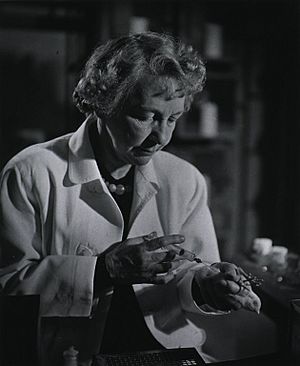Sara Branham Matthews facts for kids
Quick facts for kids
Sara Elizabeth Branham Matthews
|
|
|---|---|

Sara Branham, injecting a chick,1955
|
|
| Born | November 16, 1888 |
| Died | November 16, 1962 (aged 74) Oxford, Georgia
|
| Resting place | Oxford Historical cemetery |
| Alma mater | University of Colorado |
| Spouse(s) | Phillips S. Matthews |
| Awards | Howard Taylor Ricketts (1924) |
| Scientific career | |
| Fields | Microbiology |
Sara Elizabeth Branham Matthews (1888–1962) was an American microbiologist and physician. She was famous for her work on a germ called Neisseria meningitidis. This germ causes a serious illness called meningitis. Sara Branham found ways to identify and treat this disease.
About Sara Branham's Life
Early Life and Education
Sara Branham was born on July 25, 1888, in Oxford, Georgia. Her family believed that education was very important for women. Sara followed her mother and grandmother by attending Wesleyan College. She earned a science degree in biology in 1907.
At that time, there were not many jobs for educated women. So, Sara became a schoolteacher for ten years. She taught in public schools in Georgia.
Becoming a Scientist
In 1917, Sara started taking classes at the University of Colorado. Soon, she was hired to teach bacteriology. This happened because many men from the department were away fighting in World War I. She once said, "When I had had about six weeks of bacteriology, they offered me a job to teach it!"
She earned another science degree in 1919. This time, she studied chemistry and zoology. She realized she loved studying germs.
Studying at the University of Chicago
After her time in Colorado, Sara moved to Chicago in 1919. The world was dealing with the influenza pandemic. She wanted to help with medical research.
She went to the University of Chicago. There, she earned three more degrees with high honors. These included a master's degree, a Ph.D. in bacteriology, and a medical degree. For her Ph.D., she studied tiny germs called viruses that cause influenza. She published many papers on this topic.
Working at the National Institutes of Health
In 1927, Sara Branham started working at the University of Rochester School of Medicine. Soon after, a serious outbreak of meningococcus arrived in the United States. This disease causes meningitis.
Because of this outbreak, Sara's career changed. She joined the National Institutes of Health (NIH) in Bethesda, Maryland. She became a senior bacteriologist. Her main job was to study meningococcus.
Sara stayed at the NIH for the rest of her career. In 1955, she became the Chief of Bacterial Toxins. She retired from the NIH in 1958 when she was 70 years old.
Later Life
Sara Branham married a retired businessman, Philip S. Matthews, in 1945. He passed away four years later. Sara died on November 16, 1962, after a sudden heart attack. She is buried in Oxford, Georgia, with her family.
Sara Branham's Big Discoveries
Fighting Infectious Diseases
Sara Branham's research focused on infectious diseases. These are illnesses caused by germs. She studied many diseases like influenza, salmonella, and diphtheria.
Her most important work at the NIH was on meningitis. At the time, a new, untreatable type of meningitis was spreading fast. Sara helped solve this health problem.
Discovering and Treating Meningitis Germs
Sara Branham is known for finding and studying Neisseria meningitidis. This germ is a common cause of meningitis. She described it very well in her work.
She also found that this infection could be treated with sulfa drugs. Before this, doctors used antiserums, which did not work well for this specific type of meningitis. Her discovery saved many lives.
Because of her huge contributions, a type of germ called Neisseria catarrhalis was renamed Branhamella caterrhalis in 1970. This was years after her death. People called her one of the "grand ladies of microbiology." One newspaper article said, "She killed millions of killers!"
Beyond the Lab
Sara Branham was also active in her community. She inspired many people she worked with. She supported her old college, Wesleyan College. She gave many speeches and lectures.
She was also part of many scientific groups. She helped with the American Society for Microbiology. She attended international meetings for microbiologists in Paris and London. She was known for being good at both science and social events. She loved her home, her garden, and watching birds.
Awards and Honors
Sara Branham received many awards for her important work.
- In 1924, she won the Howard Taylor Ricketts Prize from the University of Chicago.
- In 1950, Wesleyan College gave her their first Distinguished Service Award.
- She also received a similar award from the University of Chicago Medical School Alumni Association.
- The University of Colorado gave her an honorary doctor of science degree. This was her sixth degree!
- In 1959, the American Medical Women's Association named her Medical Woman of the Year.
- In 1992, she was honored in the first group of inductees for Georgia Women of Achievement.
Over her career, Sara Branham published 80 scientific papers. She also helped write many textbooks. Her papers are kept at the National Library of Medicine.
Images for kids




